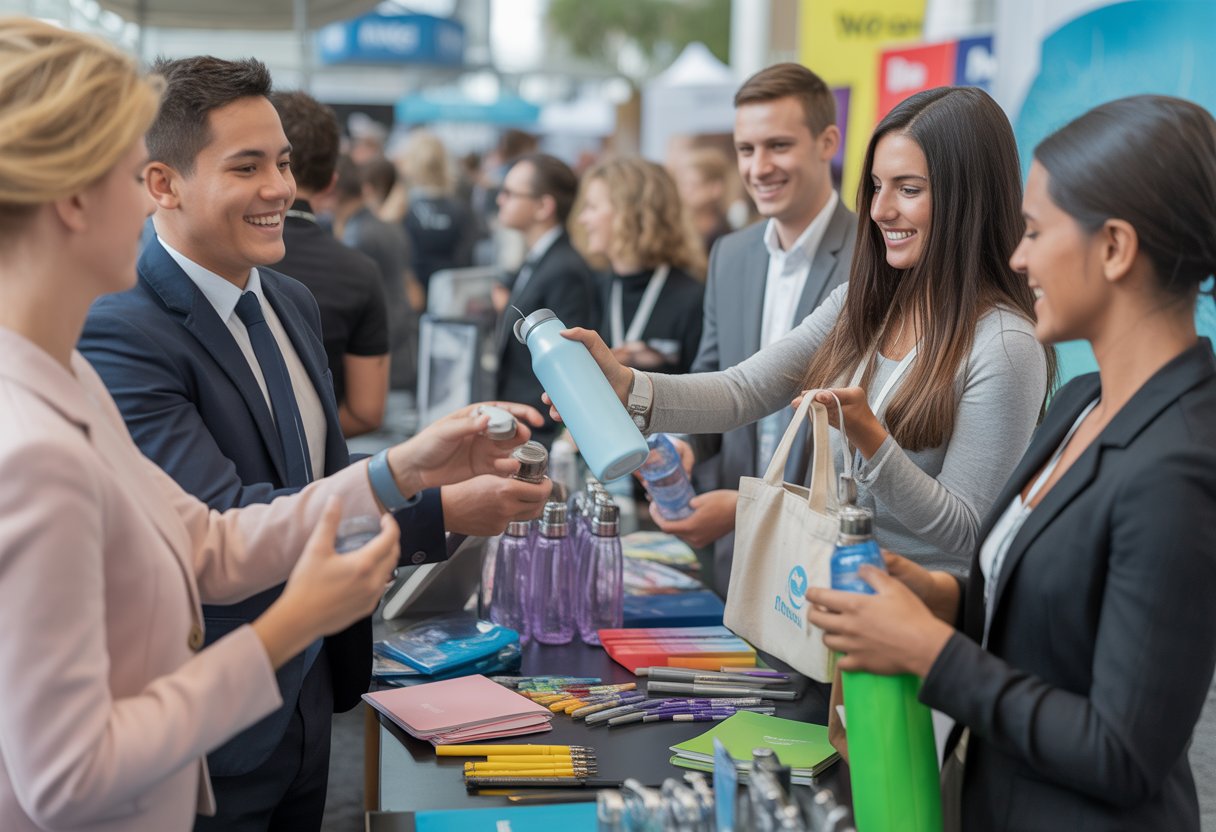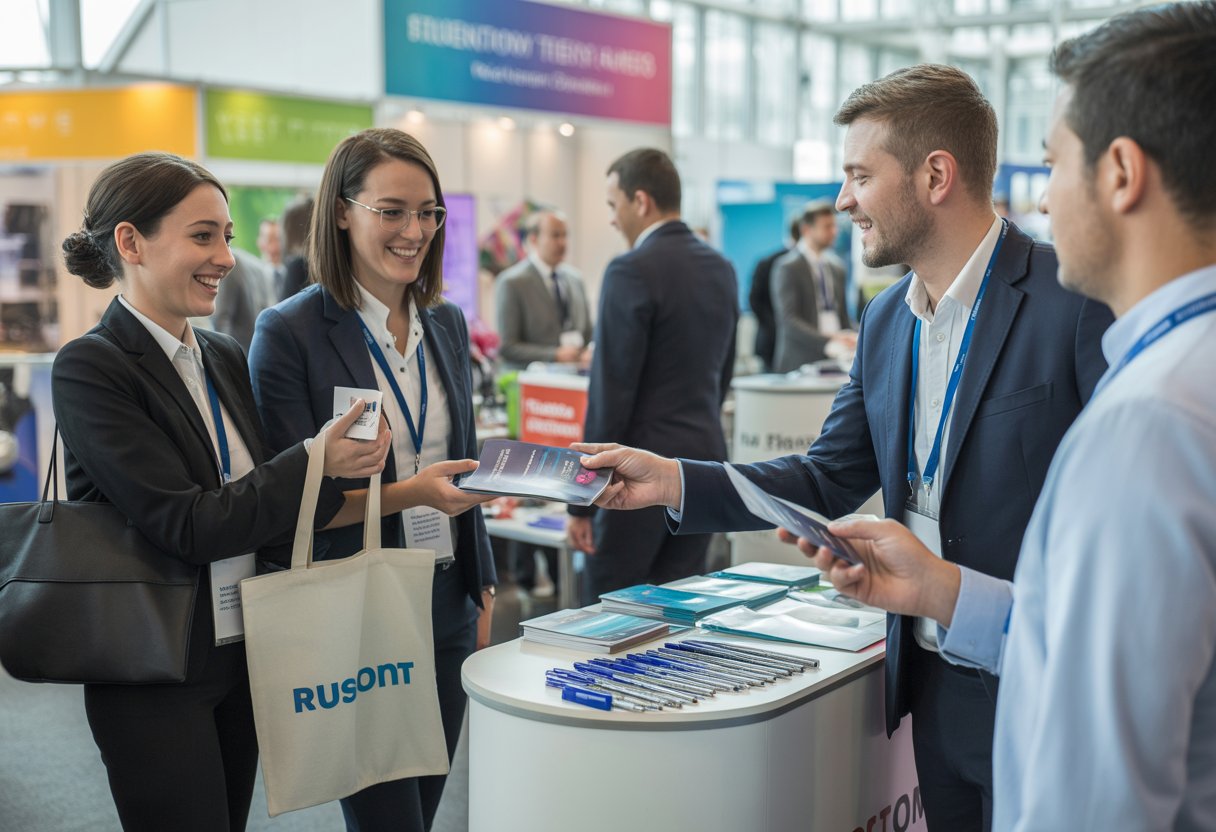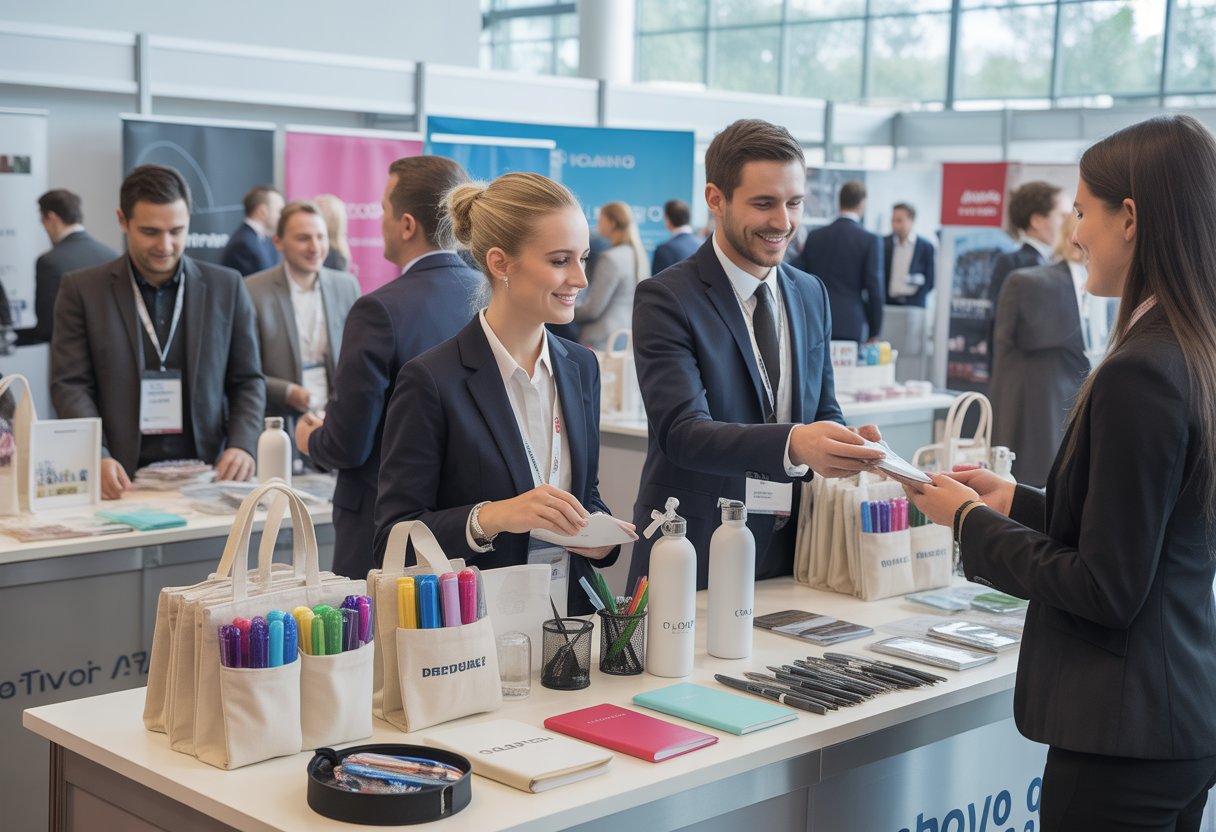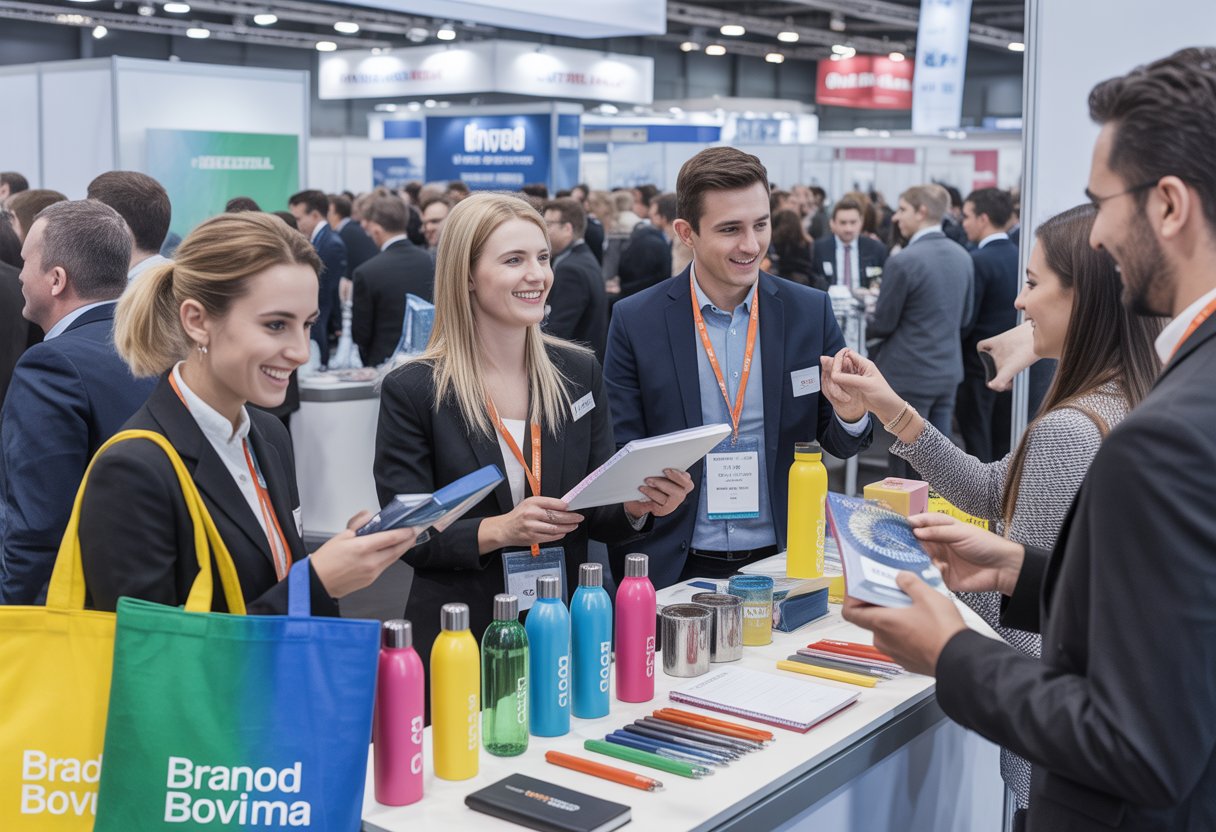Distributing promotional products at trade shows and events is a valuable strategy for attracting attention and building brand recognition. The most effective approach is to choose relevant items and hand them out at the right time and place, ensuring every giveaway matches both the event and the audience. This direct engagement creates memorable interactions that can set a brand apart from the competition.

Brands that sponsor local or themed events, or offer products that fit the occasion, often enjoy stronger results. Well-timed and thoughtful distribution helps people remember the brand long after the event ends. Each touchpoint, from the product selection to how it’s presented, matters for making a positive and lasting impression.
Understanding Your Audience and Objectives

Knowing who is attending trade shows and what the company wants to achieve will shape the success of any promotional product campaign. Focusing on specific goals and audience details leads to better results and higher customer engagement.
Market Research for Trade Shows
Thorough market research helps organisations pick the right events and plan their approach. Research includes reviewing past trade show attendance, studying event themes, and analysing exhibitor lists.
Understanding what types of professionals and businesses attend the event gives insight into what items and messages will work best. Examining previous trade show feedback or visitor data can highlight patterns in visitor interests or behaviour.
Helpful research methods include:
- Reviewing event reports and statistics
- Speaking to event organisers
- Analysing industry trends
Using this information helps tailor distribution plans so they match real-world needs and interests.
Identifying the Target Audience
It is important to define the target audience for each event. Knowing who is likely to visit the stand leads to better product choice and messaging.
A clear target audience profile may include:
- Job titles (e.g. buyers, managers)
- Company size and industry
- Demographics (age, gender, location)
- Professional needs and challenges
Identifying the main audience allows for the selection of useful, relevant promotional items that visitors actually want. This increases the chance of a meaningful connection and greater brand recall.
Setting Clear Promotional Goals
Setting clear marketing objectives ensures each promotional item is linked to a measurable outcome. Goals may include increasing brand visibility, generating qualified leads, or boosting customer engagement.
Common trade show objectives:
- Collecting business cards or sign-ups
- Booking meetings or demonstrations
- Raising awareness of a new product or service
Aligning product distribution with these goals helps track results and assess the return on investment. Specific targets also guide team efforts and keep messaging consistent throughout the event.
Selecting the Right Promotional Products

Choosing the best promotional products can help a business stand out and connect with visitors at trade shows and events. By focusing on product quality, brand alignment, cost, and personalisation, companies can maximise their impact with practical and appealing items.
Choosing High-Quality Items
High-quality products reflect positively on a brand and encourage people to use them beyond the event. Items like sturdy coffee mugs, smooth-writing pens, and durable tote bags are likely to be appreciated and kept.
Quality is often judged by how long a product lasts and how it feels in daily use. Cheap items may break quickly, creating a poor impression. A well-made product builds trust and keeps the brand visible long after the event ends. For example, branded tech gadgets or reliable office supplies can showcase attention to detail and commitment to excellence.
The key is to select products that meet a high standard, even if that means offering fewer items overall.
Aligning Products with Brand Identity
The best promotional products connect directly to a company’s brand and values. For a brand known for sustainability, reusable tote bags or recycled pens send the right message. Technology companies might choose wireless chargers or USB drives to reinforce their industry image.
Using the right colours, logos, and branding elements strengthens brand recognition. Consistent design, such as matching fonts or signature colours, helps event attendees remember the business.
A clear link between the product and the brand ensures visitors won’t just remember the giveaway—they’ll connect it to what the business stands for.
Balancing Budget and ROI
Controlling costs is critical, but the cheapest options are not always the best choice. Companies should decide how much they can spend and think about which items deliver the greatest value.
When planning, it helps to compare the potential return on investment (ROI) of different products. A higher quality pen that is used for months might offer better exposure than a larger number of low-cost plastic items that are quickly discarded.
Some businesses use a table to weigh cost against expected impact:
| Product | Cost per unit | Expected Uses | Branding Impact |
|---|---|---|---|
| Coffee Mug | £2.00 | 400+ | High |
| Tote Bag | £1.50 | 300+ | Medium |
| Pen | £0.70 | 150+ | Medium |
By focusing on quality and usefulness, businesses can make smart choices that fit the budget and boost brand awareness.
Exploring Customisation Options
Custom promotional products stand out more than generic items. Adding a company’s logo, slogan, or unique design increases the likelihood that people will remember the brand.
There are many ways to personalise merchandise:
- Embroidered logos on tote bags
- Engraved pens
- Full-colour prints on mugs or tech gadgets
Choosing the right amount of customisation is important. Overly complex designs might increase costs or slow down production. It’s best to keep branding clear and simple while still making the product feel unique. Well-chosen custom features can turn everyday office supplies into memorable marketing tools.
Maximising Brand Visibility and Engagement

Successful promotional product strategies at trade shows depend on clear branding, memorable design, and building lasting connections with visitors. Each product should help people remember the company while increasing interest and trust in the brand.
Designing for Brand Recognition
Design is a key part of brand awareness. For promotional products, the colours, shapes, and materials should match the brand identity. Consistency in these elements helps visitors remember the brand after the event.
Product selection also matters. Useful and high-quality items such as pens, tote bags, or water bottles tend to be kept for longer. This extended use increases brand exposure well beyond the trade show.
A clear, uncluttered design allows the main branding elements to stand out. Keeping messages short and using a strong visual focus makes the product more effective.
Effective Use of Logo and Branding
The logo should be highly visible and easy to recognise. It is best to place logos on areas where they will not wear off quickly, such as the side of a water bottle or front of a notebook.
Other branding elements, such as taglines or brand colours, should be clearly included without clutter. Using a consistent font and layout across all items strengthens brand recognition.
A table below shows where common branding elements can appear:
| Element | Placement Example |
|---|---|
| Logo | Main surface, label |
| Tagline | Below logo, on handle |
| Brand colours | Background, accents |
Supporting Brand Recall and Loyalty
Promotional products should reinforce brand recall. Giving items during key moments, such as product demos or competitions, makes people link the brand to a positive experience.
To encourage customer loyalty, the items should be useful and relevant to the audience. Eco-friendly choices, practical gadgets, and tech items show the brand cares about customers’ interests and values.
Including a call-to-action, like a QR code that leads to a social page or offer, supports ongoing engagement. This continual contact keeps the brand top of mind, helping foster long-term loyalty.
Distribution Strategies at Trade Shows and Events
Clear distribution strategies help brands reach the right audience at trade shows and events. Using the best methods increases brand visibility and gives promotional items a stronger impact.
In-Person Distribution Tactics
Face-to-face distribution is a leading tactic at conferences and local events. Staff can hand out promotional items directly at the stand or booth, which encourages personal interaction and builds a first impression. Placing items where there is high foot traffic, such as venue entrances or near registration areas, can reach more people.
Staff should be trained to engage each visitor, using a short script and explaining the value or use of the promotional product. Table 1 outlines effective in-person tactics:
| Tactic | Benefit |
|---|---|
| Hand-to-hand give outs | Personal connection |
| Registration desk gifts | Guarantee distribution |
| On-site demos | Product education |
A well-organised handout process ensures everyone gets the intended item and speeds up distribution during busy periods.
Interactive Giveaways and Contests
Interactive giveaways and contests at trade shows create engagement and excitement. Using a prize wheel, raffle, or digital registration can draw more visitors to the booth. Only giving out premium products to those who participate helps control costs and makes the items feel more valuable.
Contests can be structured to encourage brand interaction, such as answering a question about the company or posting about the event on social media. Benefits of contests include:
- Gathering contact information
- Generating buzz at the stand
- Encouraging longer conversations
This method also supports follow-up by collecting data from participants for lead generation after the event.
Strategic Distribution Channels
Choosing the right distribution channels matches promotional product distribution with the company’s goals. Besides in-person handouts, brands can use targeted direct mailing to deliver items before or after the event. This tactic works well for important clients or those who could not attend.
B2B events may use appointment-based gifting, where attendees collect their items during scheduled meetings. Event sponsors sometimes partner with organisers for inclusion in welcome packs or swag bags, which reaches every registered guest.
The table below compares popular channels:
| Channel | Reach | Personalisation |
|---|---|---|
| Direct mail | Selective | High |
| Booth handouts | Broad | Medium |
| Welcome packs | All attendees | Low |
By mixing these distribution methods, companies can boost brand exposure and ensure their promotional products land in the right hands.
Leveraging Digital Platforms for Enhanced Reach
Digital platforms are effective tools for boosting the visibility and impact of promotional campaigns at trade shows and events. Strong digital strategies help brands reach their target audiences before, during, and after the event.
Promoting with Social Media
Brands can use social media channels like Facebook, Instagram, and LinkedIn to announce their presence at upcoming trade shows. Posting updates about booth locations, event schedules, and exclusive giveaways creates interest and drives foot traffic.
Using event-specific hashtags and tagging the event organisers increases post reach. Sharing photos and short videos of the team setting up or interacting with attendees builds real-time engagement.
Regular content updates help keep audiences informed and encourage them to visit the booth. Brands can also use paid advertising on these platforms to target specific attendees, industries, or regions.
Running Online and Social Media Contests
Social media contests offer a direct way to engage with potential customers. Before the event, a brand can run a contest inviting people to share a post, tag friends, or use a branded hashtag for a chance to win a promotional product.
During the event, encouraging attendees to post a photo at the booth or share their experience provides authentic brand exposure. These contests not only increase online interaction but also boost attendance at the booth itself.
Results from contests are often tracked using clear criteria, such as the number of shares or posts using the event hashtag. To avoid confusion, brands should use a simple contest format and state the rules clearly in all posts.
Partnering with Influencers and Online Campaigns
Collaborating with industry influencers or key opinion leaders extends a brand’s reach beyond its direct audience. Influencers can promote the promotional campaign through their own social media channels, offering trusted recommendations to their followers.
Brands may provide influencers with samples or exclusive products, encouraging them to post reviews or unboxing videos. These partnerships often lead to increased credibility and awareness, especially if the influencer’s audience aligns with the event attendees.
Online campaigns that combine influencer promotion with branded content can build lasting engagement. Companies should track the results with simple metrics, such as clicks, shares, and new followers gained during the campaign period.
Measuring Success and Gathering Feedback
Measuring the outcomes of promotional product distribution helps organisers adjust strategies for future events. Using clear data and direct attendee feedback, companies can see what works best for building brand awareness and achieving event goals.
Tracking ROI with Analytics
To measure return on investment (ROI) at trade shows, companies often use tools such as Google Analytics. They can track website visits, sign-ups, or QR code scans linked to specific marketing materials handed out at the event. This data shows how many visitors were prompted to engage after receiving a promotional product.
Sales leads generated at the event should be tracked in a simple table, including fields for potential value and source. This helps teams compare costs against outcomes. Companies should also compare product launches with and without promotional items to see if there was a lift in engagement or sales.
Setting clear goals before the event, like increasing booth traffic by 20% or collecting 100 new leads, gives context to the numbers gathered. Regularly reviewing these analytics informs budget and product decisions for future events.
Collecting Customer Feedback
Feedback from attendees can reveal how effective promotional products are in spreading brand awareness. Organisers should send short post-event surveys via email or offer on-site feedback forms. Key questions might include:
- Did the promotional item make you remember the brand?
- Would you use the product again?
- Did the marketing materials encourage you to visit the company website?
Responses can be tallied in a table to spot trends easily. Face-to-face feedback at the event is also useful, especially soon after attendees receive products. Teams should note common compliments, complaints, or suggestions.
Involving both customers and staff in feedback gathering helps organisers discover what resonates and what might need improvement for future trade shows.



